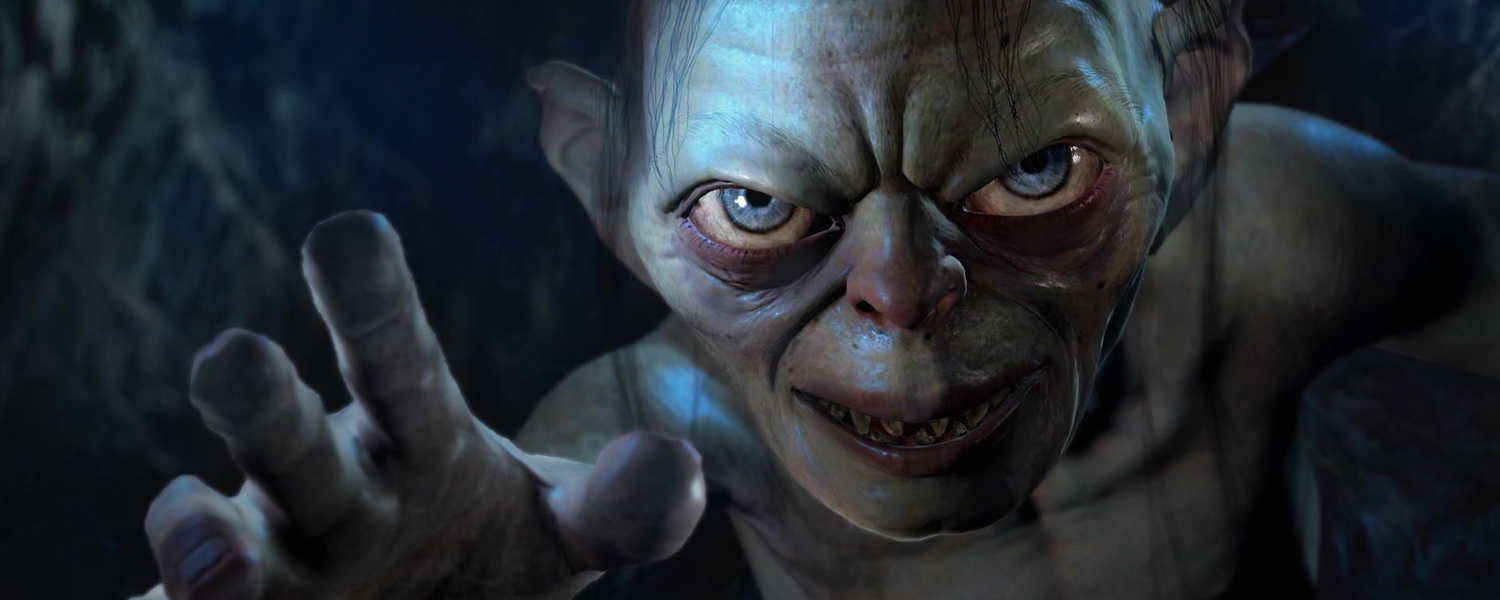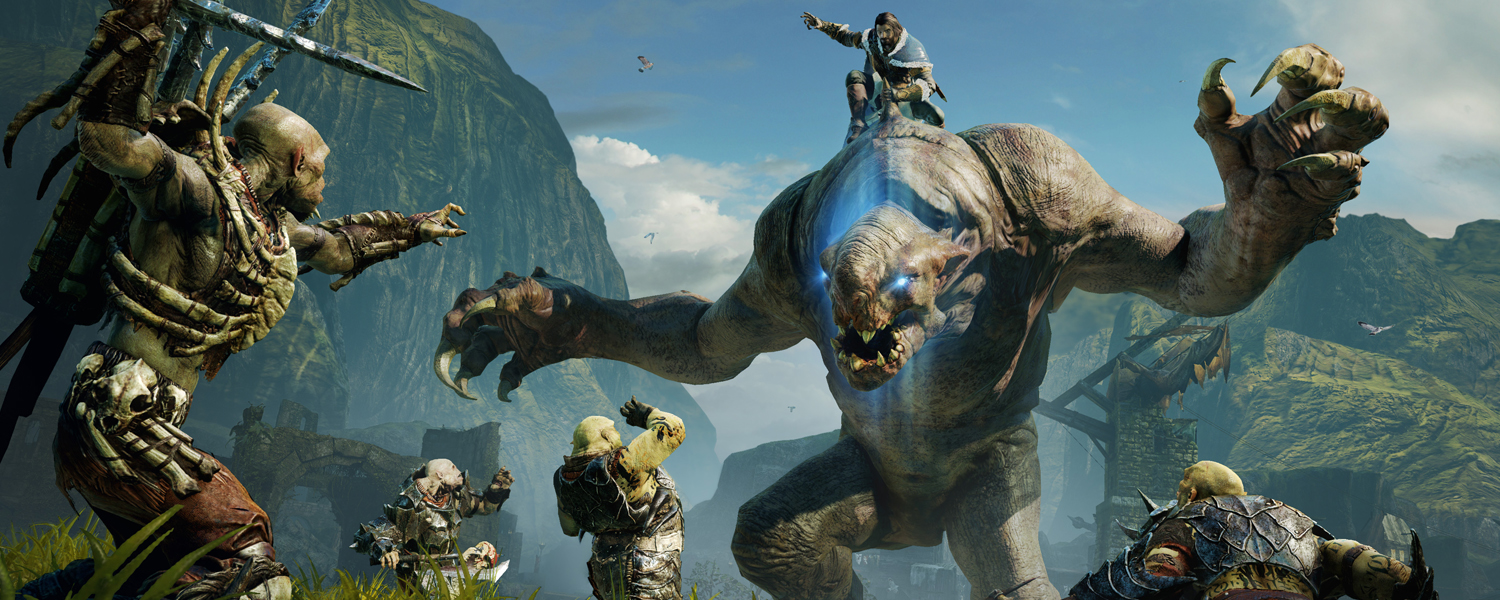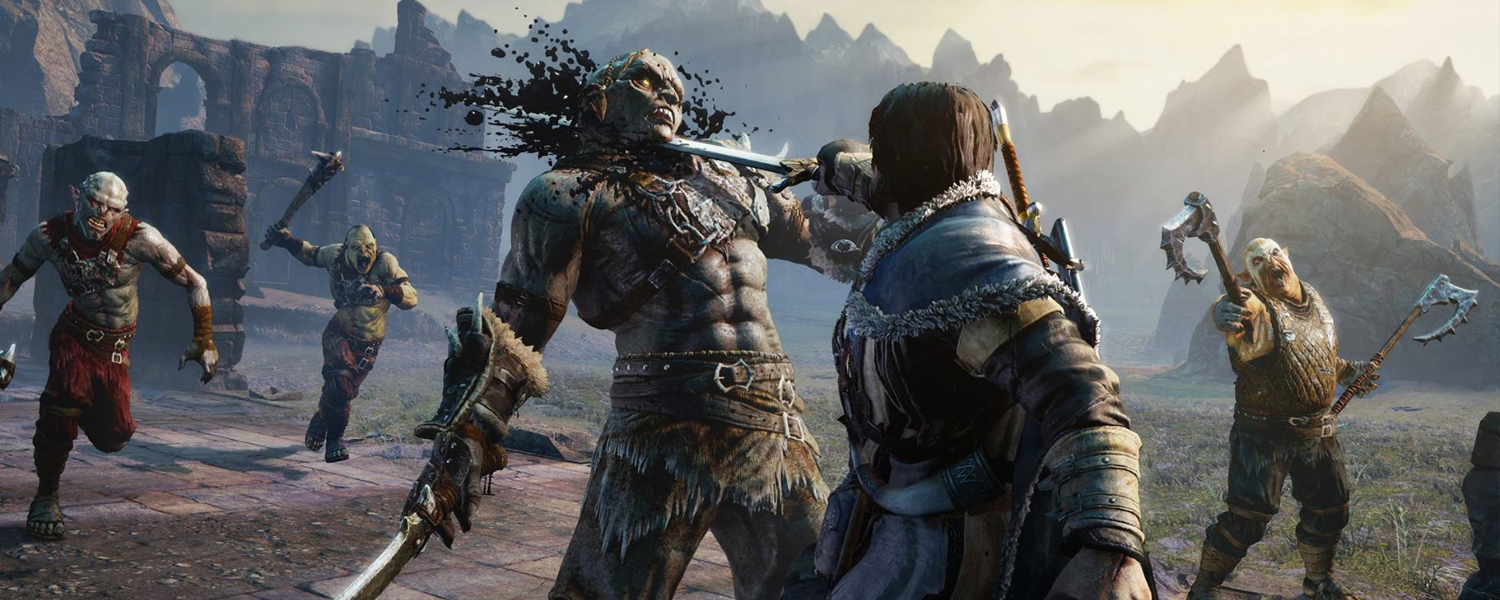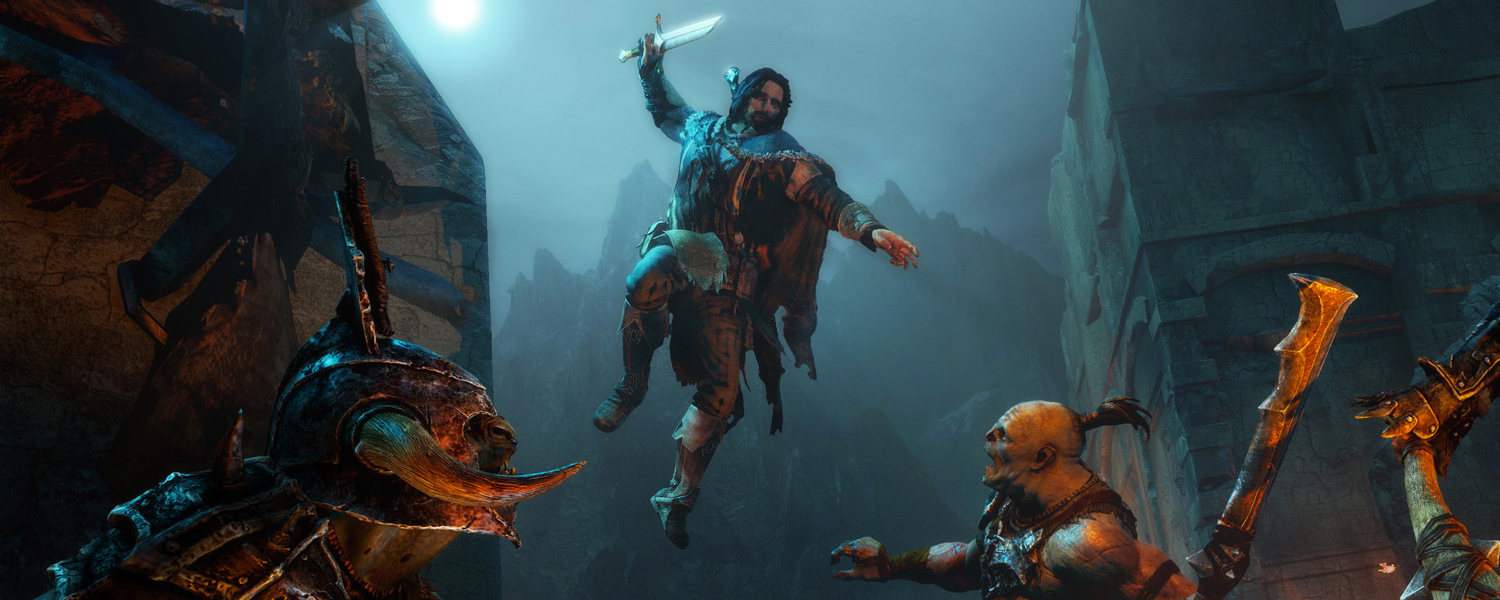
NOTE: Due to the technical differences and inconsistencies between the current and last-gen releases of Middle-earth: Shadow of Mordor this review may not be applicable to the PlayStation 3 and Xbox 360 releases of the game. Technical and gameplay experiences may vary by platform.
 Middle-Earth: Shadow of Mordor takes place between the events of J.R.R. Tolkien’s The Hobbit and The Lord of the Rings, or to be more precise between the cinematic adoptions of the novels, as Shadow of Mordor is a new story penned by the writers at Monolith and Warner Bros. Games.
Middle-Earth: Shadow of Mordor takes place between the events of J.R.R. Tolkien’s The Hobbit and The Lord of the Rings, or to be more precise between the cinematic adoptions of the novels, as Shadow of Mordor is a new story penned by the writers at Monolith and Warner Bros. Games.
The story tells the tale of Talion (voiced by Troy Baker), one of the rangers defending the Black Wall. After he and his family are murdered by Sauron’s forces he is exiled from death, and his soul and fate are fused with that of Celebrimbor (voiced by Alastair Duncan), whom also seeks vengeance against Sauron and his forces. The curse that binds them both together grants Talion the use of Celebrimbor’s wraith abilities, and together they must fight through Mordor and find the answers and vengeance they are longing for.
 Talion’s tale isn’t exactly what you’d expect when you think of the writing of the Lord of the Rings universe, and whilst it’s well-acted throughout, you might not be as interested in the outcome of the story in the end as you’d expect to be after the dark, grim and shocking introduction the game provides you with. Most of the cast is made up of new characters, though you might see some familiar faces along the way such as Gollum, whose appearance was unfortunately spoiled by the marketing department of Warner Bros.
Talion’s tale isn’t exactly what you’d expect when you think of the writing of the Lord of the Rings universe, and whilst it’s well-acted throughout, you might not be as interested in the outcome of the story in the end as you’d expect to be after the dark, grim and shocking introduction the game provides you with. Most of the cast is made up of new characters, though you might see some familiar faces along the way such as Gollum, whose appearance was unfortunately spoiled by the marketing department of Warner Bros.
The cast of characters in Shadow of Mordor is great thanks to the incredible voice work by the cast, who really add a sense of dimensionality to the game by their natural and almost film-worthy performances. Liam O’Brien especially provides a great interpretation of Andy Serkis’ performances in the films, and whilst it doesn’t reach the high notes of his cinematic counterpart it’s a notable performance none the less.
Whilst the plot of Shadow of Mordor isn’t exactly at the level of the books, it fully embraces the lore of the series itself, and it does reclaim the feeling that the books/films had by setting a similar tone. Thanks to its characters and background lore Shadow of Mordor sets up an interesting story, though the third act may lose the interest of some.
 Shadow of Mordor takes place in the title-based location of Mordor. Much of its areas are surrounded by dark and grey rock, with many ruins which the Uruk’s inhabit. There are some more colourful areas in the game itself, though this is mainly due to differences in vegetation and lighting. The grey presentation of many of its areas isn’t really a bad thing though, as it embraces the same visual style that the films presented them in, though of course we get to see much of it in more detail considering the story takes place in this single area. When the game does switch over to a more colourful setting the visuals do pop, and the design of some of the areas and characters is quite impressive.
Shadow of Mordor takes place in the title-based location of Mordor. Much of its areas are surrounded by dark and grey rock, with many ruins which the Uruk’s inhabit. There are some more colourful areas in the game itself, though this is mainly due to differences in vegetation and lighting. The grey presentation of many of its areas isn’t really a bad thing though, as it embraces the same visual style that the films presented them in, though of course we get to see much of it in more detail considering the story takes place in this single area. When the game does switch over to a more colourful setting the visuals do pop, and the design of some of the areas and characters is quite impressive.
That being said Middle-Earth of Mordor is definitely the casualty of cross-generation programming. Whilst the PC and next-gen editions of the game do look good in their own right, they often pale when compared to other cross-generation titles that we’ve experiences so far. environment textures are often less detailed than you’d expect, and the draw distance often leaves more to be desired. Especially when moving through the world at a rapid pace the LOD-scaling can be a distracting sight. Ground textures do seem to be less distracting when viewed from afar though, and their quality usually comes to question when viewed up close. The density of the vegetation is somewhat disappointing in some areas. As a whole the world is presented in a great way, and it feels incredibly authentic when exploring.

The character models do seem to stand out in a positive way, as the team at Monolith deliver highly detailed character models with impressive textures. Talion and his enemies are well-crafted from a design perspective and in close-ups its hard not to appreciate the work that has gone into their models.
The game runs at a resolution of 1080p, with a V-Synched framerate of 30 frames per second, which seemed incredibly stable throughout each of my gameplay sessions. The game also enhances the motion of the visuals by providing us with a motion-blur effect. This feature does however seem to be exclusive to the PlayStation 4 and Xbox One, whilst unusable on pc. Its use
 Middle-earth: Shadow of Mordor’s gameplay may include many existing/familiar mechanics, but its unique core is what sets the game apart. Its base could best be compared with the Assassin’s Creed franchise, due to the fighting and stealth mechanics consisting of many similar core features. The most unique feature that Shadow of Mordor apart is without a doubt the Nemesis system, which adds an incredible amount of depth to your enemies and your connection to them. Your enemies are divided by ranks, ranging from regular soldiers to captains, with each individual enemy having their own strengths and weaknesses which you’ll be able to exploit when taking them down. Information about their strengths and weaknesses is gained by interrogating lower-ranking Uruks, which will give you possible ideas about how to take them down. The unique thing here however is that if you plan things right and according to their fears, it’s possible you won’t have go into combat at all. If an enemy is vulnerable to stealth attacks you’ll simply be able to sneak up to them and take them down, or if they have a fear of a certain dangerous animal you can simply set one of them loose if there’s one in the area and you can let it take care of the situation for you. The system also gives enemies a unique connection the player himself, as they will recall earlier encounters, and possibly seek vengeance for the things you’ve done to them in the past.
Middle-earth: Shadow of Mordor’s gameplay may include many existing/familiar mechanics, but its unique core is what sets the game apart. Its base could best be compared with the Assassin’s Creed franchise, due to the fighting and stealth mechanics consisting of many similar core features. The most unique feature that Shadow of Mordor apart is without a doubt the Nemesis system, which adds an incredible amount of depth to your enemies and your connection to them. Your enemies are divided by ranks, ranging from regular soldiers to captains, with each individual enemy having their own strengths and weaknesses which you’ll be able to exploit when taking them down. Information about their strengths and weaknesses is gained by interrogating lower-ranking Uruks, which will give you possible ideas about how to take them down. The unique thing here however is that if you plan things right and according to their fears, it’s possible you won’t have go into combat at all. If an enemy is vulnerable to stealth attacks you’ll simply be able to sneak up to them and take them down, or if they have a fear of a certain dangerous animal you can simply set one of them loose if there’s one in the area and you can let it take care of the situation for you. The system also gives enemies a unique connection the player himself, as they will recall earlier encounters, and possibly seek vengeance for the things you’ve done to them in the past.
 You’ll be working up the ranks throughout the game, but failure and death also have their own consequences on your progress through the game. Dying in combat may mean the promotion of the Uruk who killed you, which will possibly let him replace an earlier enemy that you eliminated. This doesn’t necessarily have to be problematic for your progress, but none the less it definitely shows that this core mechanic isn’t all about rewarding the player, but also punishing him for his failures. Defeating a Nemesis however can greatly reward you on the weapons-front, and you’ll often be rewarded with runes, which are perks that you can equip on your weapons. These encounters are often interrupted by small cutscenes to (re)introduce these enemies, but due the spectacular voice work and characteristics you probably won’t be bothered by these brief interruptions.
You’ll be working up the ranks throughout the game, but failure and death also have their own consequences on your progress through the game. Dying in combat may mean the promotion of the Uruk who killed you, which will possibly let him replace an earlier enemy that you eliminated. This doesn’t necessarily have to be problematic for your progress, but none the less it definitely shows that this core mechanic isn’t all about rewarding the player, but also punishing him for his failures. Defeating a Nemesis however can greatly reward you on the weapons-front, and you’ll often be rewarded with runes, which are perks that you can equip on your weapons. These encounters are often interrupted by small cutscenes to (re)introduce these enemies, but due the spectacular voice work and characteristics you probably won’t be bothered by these brief interruptions.
Combat in the game is pretty straightforward, though timing is key. Prompts for dodging and evading attacks are shown throughout combat, and whilst these are only suggestive actions, ignoring them is going to cost you. During combat itself there are two main ways to take your enemy down: either take them down by hitting them repeatedly during the combat itself or finish them off whilst they’re stunned on the ground, which can be problematic if you’ve got more enemies around you to interrupt you during these finishers. The entire system is pretty robust, and whilst the button prompts may make it a bit easier, it’s not simplified to the point where you’ll be sleepwalking through encounters. If you time your attacks and defences correctly, finishing off waves of enemies can be incredibly satisfying.
 The implementation of stealth in the game is pretty robust, and whilst you’re not given a huge array of options, it’s enough to warrant a stealthy approach to many of the missions. Taking out specific enemies especially can be a very rewarding experience should the situation allow it. During one of the main missions I was given the task to kill one of the captains, and after finding out his weaknesses I chose to take a different approach than I had originally planned. Stealth takedowns can be incredibly handy, though there are no ways to move the corpses of your victims, so there’s a big chance your enemies will be aware of your presence due to them discovering a body of one of your previous kills. Certain areas will also have the drawback of having an alarm bell present, which enemies can use to signal their allies should they spot you in the area, which can be pretty problematic when taking a stealthy approach. Taking down specific enemies may not always be possible with stealth, due to the fact that some may simply not be vulnerable to these finishers.
The implementation of stealth in the game is pretty robust, and whilst you’re not given a huge array of options, it’s enough to warrant a stealthy approach to many of the missions. Taking out specific enemies especially can be a very rewarding experience should the situation allow it. During one of the main missions I was given the task to kill one of the captains, and after finding out his weaknesses I chose to take a different approach than I had originally planned. Stealth takedowns can be incredibly handy, though there are no ways to move the corpses of your victims, so there’s a big chance your enemies will be aware of your presence due to them discovering a body of one of your previous kills. Certain areas will also have the drawback of having an alarm bell present, which enemies can use to signal their allies should they spot you in the area, which can be pretty problematic when taking a stealthy approach. Taking down specific enemies may not always be possible with stealth, due to the fact that some may simply not be vulnerable to these finishers.
Middle-earth: Shadow of Mordor provides the player with about 20 main story missions, though there is a wide array of side-missions available that will make your gameplay experience much more robust and lengthy experience. But the Nemesis system will probably be a more attractive reason to revisit the game for some players. The side-missions offer a decent variety, and sometimes it may be nice to take a breather from the story and simply cause some havoc amongst your enemies, which is pretty rewarding in its own right.





